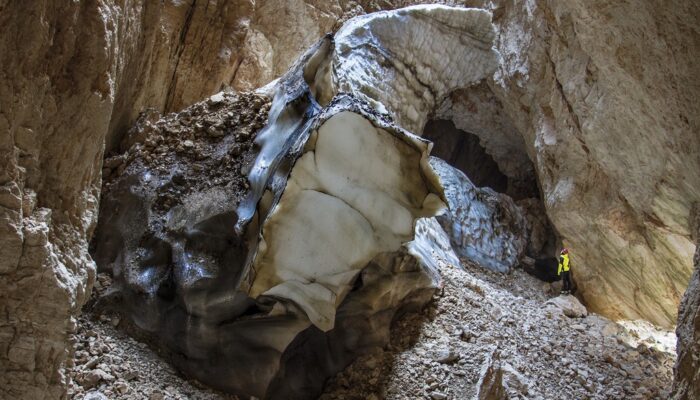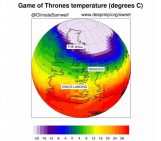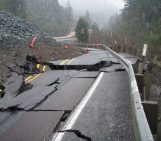
The winter season is a good time to take advantage of cold weather activities, whether that’s hitting the ski slopes or warming up by a fire, but for Renato R. Colucci, it’s also one of the best time’s to study the Earth’s underground cryosphere.
Colucci, who took this featured photograph, is a researcher at Italian Institute for Marine Sciences (ISMAR) of the National Research Council (CNR) and is a scientific lead partner for the Cave’s Cryosphere and Climate project, C3 for short. The C3 project aims to monitor, study, date, and model alpine ice cave environments.
This photo was taken by Colucci while he and the C3 project team were surveying a large ice deposit in the Vasto cave, situated within the Southeastern Alps of Italy. Speleologists of the E. Boegan Cave Commission began documenting the caves in this region in the 1960s, making it a great site for studying underground cryosphere today. For the past few years the C3 team has been monitoring the microclimates of these caves as well as analysing how the ice masses within are melting and accumulating ice.
There are many different kinds of ice deposits in caves, but the main difference is how these types accumulate their frozen mass. For some cave ice deposits, like the one featured in this photo, the snowfall that reaches the cave interior amasses over time into solid layers of ice, as is typical for many glaciers. However, other deposits take form when water from melting snow or rain percolates through rock’s voids and fractures, then freezes and accumulates into permanent ice bodies in caves.
These high-altitude underground sources of ice are a lesser-known faction of the cryosphere since they are not very common or reachable to scientists, but still an important one. Often the permanent ice deposits in caves contain pivotal information on how Earth’s climate has evolved over time during the Holocene.
However, if the Earth’s global temperatures keep increasing, this data might not be available in the future. While ice masses in caves are more resilient to climate change compared to their aboveground counterparts, many of these deposits, and the vital data they store, are melting away at an accelerating rate. “Global warming is rapidly destroying such important archives,” said Colucci.
Through this project, the researchers involved hope to better understand the palaeoclimate information stored in these deposits and how the ice will respond to future climate change.
By Olivia Trani, EGU Communications Officer
Imaggeo is the EGU’s online open access geosciences image repository. All geoscientists (and others) can submit their photographs and videos to this repository and, since it is open access, these images can be used for free by scientists for their presentations or publications, by educators and the general public, and some images can even be used freely for commercial purposes. Photographers also retain full rights of use, as Imaggeo images are licensed and distributed by the EGU under a Creative Commons licence. Submit your photos at http://imaggeo.egu.eu/upload/.




